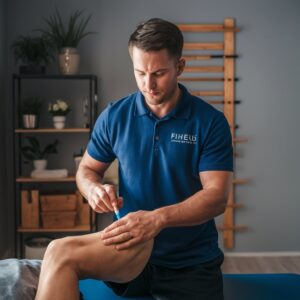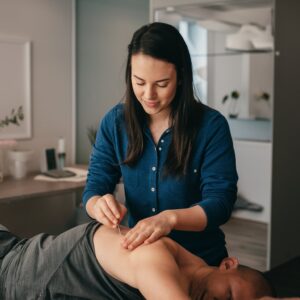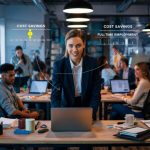Enhancing Manual Therapy with Dry Needling
Physical therapists, chiropractors, and other medical professionals use dry needling as an effective therapeutic technique for addressing musculoskeletal pain and movement disorders. Tiny needles are strategically inserted into targeted pressure points on the body, relieving stress and pain. Dry needling is grounded in Western medicine and neurophysiology, distinguishing it from acupuncture, rooted in traditional Chinese medicine.
The primary goal of dry needling is to locate and address trigger points and hyperirritable areas in skeletal muscle that may result in noticeable nodules or tense bands. These trigger points can often cause localised and referred pain, restricted movement, and muscle weakness. Nevertheless, dry needling provides a glimmer of hope and positivity by alleviating pain and enhancing functional ability by releasing these trigger points.
When it comes to comprehensive treatment plans that include physical therapy, exercise, and other forms of treatment, dry needling is a safe and effective procedure that plays a crucial role. This task should only be carried out by highly trained and certified healthcare professionals who have undergone specialised training to ensure the safety and well-being of the patient. You can be confident that patients will receive clear and thorough information regarding the potential advantages and risks of the procedure before undergoing therapy.
This approach is effective in addressing musculoskeletal pain and can be combined with other manual therapy interventions.
Main Points
- Dry needling is a highly effective method for alleviating pain and enhancing functionality. It entails the precise insertion of thin needles into specific muscle trigger points.
- The science behind dry needling revolves around stimulating the nervous system and encouraging the release of natural pain relievers to alleviate muscle tension and enhance blood circulation.
- Combining dry needling with manual therapy can significantly improve treatment results by effectively targeting the soft tissue pain associated with musculoskeletal pain.
- Utilising dry needling techniques, muscle trigger points are effectively targeted to alleviate pain and enhance the range of motion. This makes it an invaluable resource for effectively managing muscle pain.
- Musculoskeletal pain can be effectively addressed by incorporating dry needling alongside joint mobilisation techniques. This approach targets the affected tissue and joint structures, providing a comprehensive treatment solution.
 The Science Behind Dry Needling: How it Works to Relieve pain
The Science Behind Dry Needling: How it Works to Relieve pain
Local Twitch Response and Muscle Relaxation
A needle inserted into a trigger point can elicit a local twitch reaction, causing the muscles surrounding the needle to contract reflexively. This twitch reaction is thought to help relieve muscle tension and break the cycle of dysfunction and discomfort.
Exploring the Benefits of Pain Relief and Neurophysiological Effects
When the needle is inserted, it can stimulate the body’s natural painkillers, known as endorphins. This leads to quick pain relief and a decrease in muscle soreness. In addition, dry needling can potentially impact the nervous system by altering sensory nerve activity and reducing the transmission of pain signals to the brain. This can help desensitise the nervous system and minimise the sensation of pain.
Understanding the Process of Local Blood Flow and Tissue Healing
Dry needling induces microtrauma at the insertion site, leading to enhanced local blood flow and improved tissue repair. Enhancing the oxygen and nutrient levels in the area while eliminating metabolic waste products can have a positive impact. Understanding the science behind dry needling allows for a deeper appreciation of its impact on the body, such as reducing pain and improving overall function.
Integrating Dry Needling with Manual Therapy: Enhancing Treatment Outcomes
The effectiveness of treating musculoskeletal pain and dysfunction can be enhanced by incorporating manual therapy techniques like joint mobilisation, soft tissue mobilisation, and stretching dry needling. Manual therapy aims to restore the natural movement of joints and soft tissues, while dry needling relieves trigger points and muscle tension. By combining these approaches, healthcare practitioners can effectively tackle both the mechanical and neuromuscular aspects of pain and movement limitations.
Suppose a patient is experiencing symptoms of shoulder pain and limited mobility due to a rotator cuff injury. In that case, a physical therapist may use manual techniques to improve joint mobility. Additionally, they may use dry needling to target trigger points in the muscles and provide relief. By combining both methods, you can experience enhanced pain relief, increased range of motion, and improved functional activities. In addition, the combination of dry needling and manual therapy can help prolong the benefits of treatment by addressing both the root cause of musculoskeletal dysfunction and the resulting pain.
Healthcare providers should understand manual therapy and dry-needling techniques to integrate them into treatment programs successfully. Just as crucial is educating patients, as it plays a vital role in helping individuals grasp these therapies’ purpose and anticipated outcomes. By integrating these treatments, healthcare practitioners can provide comprehensive therapy to patients experiencing musculoskeletal discomfort.
Targeting Trigger Points: Using Dry Needling for Muscle Pain Relief
Utilising dry needling techniques, muscle trigger points can be effectively targeted to alleviate muscle discomfort and dysfunction. Palpable nodules or taut bands often accompany hyperirritable areas in skeletal muscle. These websites may lead to localised and transferred discomfort, limited range of motion, and muscle atrophy.
Healthcare providers are crucial in ensuring a safe and effective dry-needling procedure. By strategically inserting tiny needles into specific trigger points, a local twitch response is triggered, releasing muscle tension and relieving patients. For instance, if a patient is experiencing low back pain that worsens with prolonged sitting, a physical therapist’s professional knowledge can help identify trigger points in the paraspinal muscles that may be causing the discomfort. A skilled practitioner can effectively relieve pain and tension by utilising dry-needling techniques in these specific areas.
In addition, utilising dry needling to address trigger points can improve muscle flexibility and function, allowing individuals to experience greater mobility and perform daily tasks with less discomfort. An in-depth assessment by healthcare professionals is essential to pinpoint trigger points and determine if dry needling is a suitable treatment option. It is important to provide patients with clear information about what they can expect during their dry needling therapy, including any possible side effects or warnings.
Healthcare providers have the expertise to address muscular discomfort and dysfunction by focusing on trigger points through dry needling, a therapy that has been proven effective.
 Combining Dry Needling with Joint Mobilization: Addressing Musculoskeletal Pain
Combining Dry Needling with Joint Mobilization: Addressing Musculoskeletal Pain
Combining joint mobilisation procedures with dry needling can effectively address musculoskeletal pain and movement limitations by targeting trigger points within muscles. Joint mobilisation involves applying precise pressures to a joint to restore its natural range of motion and provide relief from pain. By incorporating physical needling into joint mobilisation therapies, healthcare professionals can efficiently address both the muscular and articular components of musculoskeletal disorders.
For example, if a patient is suffering from knee pain due to patellofemoral dysfunction, a physical therapist can use joint mobilisation techniques to improve the movement of the patella. In addition, they can use dry needling to relieve trigger points in the quadriceps muscles. This comprehensive approach can alleviate discomfort and improve functional activities like walking, climbing stairs, and squatting. By addressing the joint and muscular components of dysfunction, healthcare practitioners can enhance patient care and provide a more comprehensive approach.
Healthcare providers should thoroughly understand joint mobilisation and dry-needling procedures to effectively integrate them into treatment programs. Equally crucial is educating patients, encouraging them to care for themselves and prioritising their long-term well-being. It assists individuals in comprehending the rationale behind these interventions and the anticipated treatment results. By incorporating these methodologies, medical professionals can provide a more comprehensive approach to treating individuals with musculoskeletal discomfort. This approach emphasises a dedication to their patients’ long-term health and well-being.
Addressing Neuropathic Pain: The Role of Dry Needling in Nerve Pain Management
Gaining Insight into Neuropathic Pain
Neuropathic pain is a complex condition that occurs when the neurological system is damaged or impaired. These symptoms can cause shooting or burning sensations, numbness, or tingling. Neuropathic pain trigger points can be located either along nerve pathways or in muscles supplied by the affected nerves.
Dealing with Sciatica through Dry Needling
For example, people with sciatica may suffer from neuropathic pain caused by compression or irritation of the sciatic nerve. By strategically identifying and treating specific trigger points along the sciatic nerve pathway, skilled healthcare practitioners can effectively alleviate distressing symptoms like leg pain and numbness. This method can alleviate neuropathic pain and enhance functionality by relieving tension in nerve trigger points.
Maximising the Benefits of Dry Needling for Nerve Pain Relief
Healthcare providers need to have a thorough understanding of nerve anatomy and neuropathic pain syndromes to effectively use dry needling to manage nerve pain. They should also provide patients with comprehensive information about the treatment process and any potential risks or precautions that may be associated with dry needling on nerve-related trigger points. Healthcare providers have the expertise to effectively address nerve-related symptoms by using dry needling to target neuropathic pain.
 Patient Education and Safety: Exploring the Benefits and Risks of Dry Needling in Manual Therapy
Patient Education and Safety: Exploring the Benefits and Risks of Dry Needling in Manual Therapy
Patient education is essential when incorporating dry needling into manual therapy treatments. It is crucial for individuals undergoing dry needling to have a thorough understanding of the therapy’s potential benefits and risks. Healthcare providers should prioritise dedicating ample time to explaining the intricacies of dry needling, offering a thorough explanation of the treatment procedure, and openly discussing any potential adverse effects, such as temporary discomfort or discolouration at the needle insertion sites.
In addition, educating patients about the safety precautions related to dry needling is essential. It is important to avoid strenuous physical activity immediately after the procedure and promptly notify the healthcare provider of any unusual or prolonged symptoms. Patients must understand that dry needling can be a valuable treatment option for musculoskeletal discomfort, but it may not suit everyone or every condition. Healthcare providers can enhance patient comfort during sessions by improving patient education on dry needling and empowering them to make well-informed decisions regarding their treatment options. This, in turn, can effectively reduce anxiety and significantly improve the overall treatment experience.
In addition, it is crucial to foster transparent and open communication between patients and healthcare professionals to address any concerns or questions related to dry needling effectively. Patient education is crucial for ensuring safety and achieving positive outcomes when incorporating dry needling into manual therapy procedures. In manual treatment strategies, dry needling is a highly advantageous method for addressing musculoskeletal pain and movement limitations.
Healthcare practitioners can enhance patients’ care by directing their attention towards trigger points within muscles and incorporating this technique with other manual therapy procedures, such as joint mobilisation. Moreover, dry needling can precisely focus on trigger points associated with nerve damage, providing relief from neuropathic pain. Ensuring that patients have access to thorough information is crucial in helping them understand the potential benefits and limitations of dry needling as part of their treatment plan.
A deep understanding of the mechanics and patient safety concerns is crucial when incorporating dry needling into manual therapy techniques to relieve musculoskeletal pain effectively.
Could you please explain what dry needling is?
Manual therapists, including physical therapists and chiropractors, use dry needling to address musculoskeletal pain and movement limitations. This procedure entails inserting fine needles into specific areas of muscle tension or trigger points, prompting the body to initiate a healing process.
Could you please explain how dry needling works?
Dry needling is all about targeting those pesky trigger points. These trigger points are annoying hyperirritable spots in the skeletal muscle, often accompanied by palpable nodules in taut bands of muscle fibres. Strategically inserting a needle into these trigger points can effectively release tension and promote better blood flow to the area, reducing pain and improving comfort overall.
Are dry needling and acupuncture considered to be the same thing?
Although dry needling and acupuncture utilise thin needles, they are distinct techniques based on separate principles. Acupuncture is rooted in ancient Chinese medicine and aims to rebalance the body’s energy flow, known as qi, by targeting specific meridians. On the other hand, dry needling follows Western medicine principles and focuses on addressing particular musculoskeletal problems.
Which conditions can be alleviated through dry needling?
Dry needling is an effective treatment option for various musculoskeletal conditions. These conditions may include neck, back, shoulder, hip, knee, and headaches, among others. In addition, it can effectively target muscle tightness, joint stiffness, and movement impairments.
Is dry needling considered safe?
Dry needling is generally regarded as safe when performed by a skilled and licensed manual therapist. However, like any medical procedure, there are potential risks and side effects to consider. These may include bruising, soreness, and, in rare cases, infection. It is crucial to receive treatment from a skilled and seasoned practitioner.
What is the usual number of dry needling sessions required?
The number of dry-needling sessions required may differ based on the individual and the specific condition being addressed. Individuals may notice considerable improvement following a single session, while others may need multiple sessions to achieve their desired results. A skilled therapist can assist you in navigating the suggested treatment plan that aligns with your specific requirements.
References:
- Trigger Point Dry Needling. https://www.strattonspine.com/services/trigger-point-dry-needling/
- Health Benefits of Physiotherapy | How We Can Help You. https://www.corefitness.com.sg/benefits-of-physiotherapy-clinical-pilates/
Brought To You By:
The Article: Integration of Dry Needling in Manual Therapy appeared first on Dry Needling Clayton-le-Woods Preston
The Article Dry Needling & Manual Therapy appeared first on https://mcrtherapies.com
The Article Dry Needling & Manual Therapy Was Found On https://limitsofstrategy.com


I found your insights on dry needling particularly thought-provoking, especially regarding its distinction from acupuncture. It’s fascinating how different practices can emerge from varied traditions yet converge in their goals of alleviating pain and restoring function. This difference also highlights the importance of understanding patient preferences and beliefs when it comes to pain management strategies.
It’s interesting to hear your perspective on the distinctions between dry needling and acupuncture. You raise a significant point about how these treatment modalities, while aiming to alleviate pain, stem from different historical and cultural contexts. Dry needling is often grounded in Western anatomical and neurological principles, focusing specifically on muscle trigger points to promote healing. Conversely, acupuncture is steeped in ancient Chinese philosophy, incorporating concepts like Qi and the balance of energies within the body.
You’ve really captured the essence of both practices in your comment. It’s fascinating how, despite dryness in their nomenclature, dry needling and acupuncture represent such expansive philosophies. I appreciate your mention of “Qi” because that concept of energy flow and balance is something that resonates deeply in so many holistic approaches beyond just acupuncture.
I completely resonate with your observations on dry needling and acupuncture. It’s intriguing how these techniques, despite having different origins, can overlap in their ultimate aim of pain relief and enhancing overall function. I find it particularly interesting how patient preferences and beliefs play such a critical role in determining which approach might resonate more with someone.
It’s really fascinating to think about how dry needling and acupuncture can serve similar purposes, even with such different historical contexts. I’ve always been intrigued by the power of belief and patient preference in those scenarios. It reminds me of how our individual narratives shape our experiences with healing.
You raise an interesting point about the intersection of belief and healing. It’s true that both dry needling and acupuncture, while rooted in different traditions, highlight the significance of context and individual narratives in the healing process. I’ve often thought about how our expectations and personal stories can influence the efficacy of various treatments—both conventional and alternative.
You’ve highlighted a key aspect of healing that often gets overlooked—how our beliefs and personal narratives shape not just our experiences but also the outcomes of various treatments. I think about that a lot in the context of how different cultures view health and wellness. For instance, in some cultures, the act of seeking treatment is as much about community and connection as it is about the physical ailment. That social aspect can really enhance the healing experience.
The connection between belief and healing is a fascinating aspect to explore. I appreciate your thoughts on how context and individual narratives can play such a significant role in the effectiveness of treatments, whether they come from conventional or alternative backgrounds. When we look at modalities like dry needling and acupuncture, it seems that the stories we bring to the table can shape our experiences in remarkable ways.
You’ve touched on such an important and nuanced topic. The connection between belief and healing really does deserve more attention, especially as we navigate a landscape filled with various treatment options. I’ve found that the stories and expectations people bring can dramatically affect their experiences, whether they’re seeking relief from chronic pain through dry needling or exploring the ancient practices of acupuncture.
You bring up such a fascinating point about patient preferences and beliefs. It’s something I think about often when discussing complementary therapies like dry needling and acupuncture. It’s amazing how personal experiences and cultural backgrounds can shape our views on these practices. For many, acupuncture may feel more holistic and aligned with traditional wellness philosophies, while others might lean toward dry needling for its more clinical, modern approach.
You really touched on something important with patient preferences and beliefs. It’s intriguing how personal experiences and cultural backgrounds can profoundly shape our views on treatments like acupuncture and dry needling. I’ve seen this dynamic play out in my own life—my grandmother swore by acupuncture for everything from back pain to stress relief, often sharing her perspective that it connects the body and mind in a way that traditional Western medicine lacks. Meanwhile, I’ve talked to friends who appreciate the straightforward approach of dry needling, citing its efficacy for muscle tension and injury recovery.
You’ve touched on a really important point. The distinction between dry needling and acupuncture often leads to some misconceptions, but at the heart of both practices is a common goal: to help people manage pain and improve their quality of life. It’s interesting how the context and approach can vary so much; acupuncture often draws from a rich tradition rooted in Eastern philosophies, while dry needling is more closely aligned with Western anatomy and physiology.
You’ve touched on a really important point. The distinction between dry needling and acupuncture does indeed lead to misconceptions, especially because they both utilize needles in different ways. I think it’s fascinating how the methods reflect the cultural contexts from which they arise. With acupuncture’s deep roots in Eastern philosophies, there’s a holistic perspective that considers not just the physical symptoms but also emotions and overall balance.
You bring up an interesting point about the distinction between dry needling and acupuncture. It’s fascinating how practices can stem from different cultural backgrounds yet address similar issues like pain and mobility. I often think about how our understanding of pain management has evolved over the years.
I really appreciate your perspective on the distinctions between dry needling and acupuncture. It’s true that both practices, while rooted in different philosophies, ultimately aim for the same outcome: relieving pain and enhancing overall well-being.
I really appreciate your perspective on the distinctions between dry needling and acupuncture. It’s true that both practices, while rooted in different philosophies, ultimately aim for the same outcome: relieving pain and enhancing overall well-being. It’s fascinating how these two approaches highlight the diversity in healing practices, isn’t it?
I found an article that dives deeper into how dry needling and manual therapy work together for pain relief, which complements your thoughts perfectly.
‘Dry Needling and Manual Therapy: Effective Treatment Options for Pain Relief’
https://lvabj.org/dry-needling-and-manual-therapy-effective-treatment-options-for-pain-relief/.
I completely agree with you on the fascinating nature of the distinctions between dry needling and acupuncture. It’s interesting how both practices, despite their different philosophical roots, can be woven together to create a more comprehensive approach to pain management. The fact that they share the common goal of promoting well-being really opens up discussions about how various healing modalities can complement one another.
Your observation about dry needling and acupuncture hits at the core of what makes healing such an intriguing field. The way these two practices emerge from distinct philosophical backgrounds yet share a common goal of alleviating pain and promoting well-being is a testament to the rich tapestry of healing arts. It’s almost like different languages expressing the same fundamental truths about the human body.
It’s interesting how both dry needling and acupuncture draw on the body’s energy but approach it from different angles. While dry needling focuses on releasing muscle tension and trigger points, acupuncture seeks to balance the flow of qi throughout the body. This distinction is vital because it influences how each method is applied in practice.
It’s great to see that you resonate with the points made about the distinctions between dry needling and acupuncture. You’re spot on about how both practices, despite coming from different cultural and philosophical backgrounds, share a common goal of alleviating pain and improving overall well-being. It’s fascinating how these methods can complement each other in therapeutic settings, and understanding their unique approaches adds depth to our appreciation of them.
I appreciate your thoughts on dry needling and its differences from acupuncture. It’s so interesting to see how these therapies originate from such distinct cultural backgrounds yet aim to help individuals in similar ways. I’ve often wondered how much a patient’s cultural context or personal experiences can shape their perceptions and outcomes with these treatments.
I really appreciate the insights you’ve shared about dry needling. It’s fascinating how a technique rooted in Western medicine can complement manual therapy and physical rehabilitation so effectively. I remember when I first learned about dry needling in my physical therapy classes; the science behind trigger points really opened my eyes to how interconnected our muscles, nerves, and overall body mechanics are.
It’s interesting to hear how your perspective changed when you learned about dry needling and trigger points. I completely agree that understanding these concepts can really open up a whole new dimension of how we view the body’s mechanics. The interconnectedness of our muscles and nerves is truly fascinating, and it makes you appreciate how everything works together for overall wellness.
I appreciate your thoughts on how learning about dry needling and trigger points reshapes our understanding of the body’s mechanics. It’s intriguing to think about how, for many of us, the body often appears as a collection of isolated parts, rather than a complex web of interconnections.
Your exploration of dry needling as a therapeutic intervention strikes a chord, particularly in an era where integrative care models are gaining traction among healthcare professionals. The distinction you draw between dry needling and acupuncture is crucial, as it helps demystify these techniques for those unfamiliar with them.
It’s interesting to see how the conversation around integrative care is evolving. Your point about the growing acceptance of techniques like dry needling really highlights a shift in how we approach treatment. I’ve noticed more practitioners blending different modalities to create personalized care plans, which seems to resonate well with patients.
I’m glad the discussion on dry needling resonates with you. It’s fascinating to see how integrative care is evolving and how different practices can complement one another. The differences between dry needling and acupuncture often spark curiosity, and it’s important to clarify that while they may seem similar at first glance, their goals and approaches are distinct.